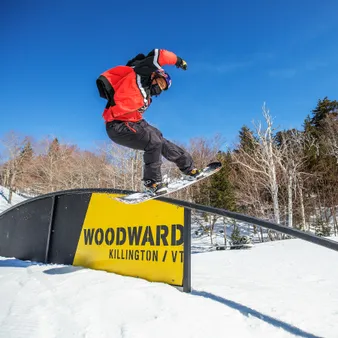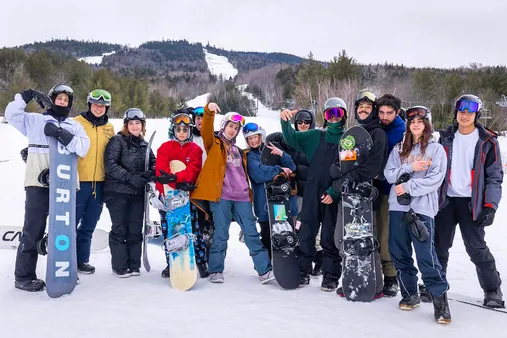Table of Contents
In the realm of exhilarating winter sports, Snowboarding stands tall as a captivating pursuit that blends adrenaline, grace, and the beauty of nature. At Kizworld, we're passionate about snowboarding and dedicated to providing you with the ultimate snowboarding experience. Whether you're a seasoned pro or a curious beginner, our comprehensive guide will equip you with the knowledge and inspiration to embrace the slopes with confidence and style.
Snowboarding: Shred the Slopes, Embrace the Exhilaration!
I. Instructional how-to videos contribute to the fun and skill-building
The educational value of instructional videos
Well explained and produced instructional videos are a great tool to learn new snowboarding skills and tricks. They can help you understand the basic mechanics of a maneuver, see how it's done by an experienced rider, and practice it yourself.
How-to videos can also be helpful for troubleshooting problems you're having with your snowboarding technique. If you're not sure why you're not landing your jumps or carving your turns as well as you'd like, watching a video can help you identify the areas where you need to improve.
Pros |
|---|
Cons |
The motivational power of instructional videos
In addition to teaching you new skills, instructional videos can also be a great source of motivation. Watching videos of other riders doing amazing things can inspire you to push your own limits and try new things.
They can also be a great way to stay motivated when you're feeling stuck in a rut. If you're in need of some inspiration, watching a video of a pro rider doing something incredible can help you get excited about snowboarding again.
How to find the best instructional videos
With so many instructional videos available online, it can be tough to know where to start. Here are a few tips for finding the best videos for you:
- Consider your skill level. If you're a beginner, you'll want to find videos that are geared towards your specific skill level.
- Read the reviews. Before you watch a video, take a look at the reviews to see what other people have to say about it. This can help you weed out the bad videos and find the ones that are worth your time.
- Watch the video trailer. If a video has a trailer available, watch it to get a sense of the content and the teaching style of the instructor.
- Start with the basics. Once you've found a few videos that you like, start with the basics. Don't try to learn too much at once. Focus on one or two new skills at a time and practice them until you've mastered them.How to Choose the Right Snowboard for Your Skill Level and Style
II. Places to hit the slopes
Places to hit the slopes
Top destinations for snowboarding enthusiasts
Snowboarding is a thrilling and exhilarating sport that attracts adventurers from all over the world. Whether you're a seasoned pro or a first-timer, there are countless destinations that offer pristine slopes, breathtaking views, and an unforgettable snowboarding experience. Here are some of the top places to hit the slopes:
- Aspen Snowmass, Colorado: Known for its world-class terrain, Aspen Snowmass offers four distinct mountains with over 3,300 acres of skiable terrain. From gentle slopes for beginners to challenging runs for s, there's something for everyone at this iconic resort.
- Whistler Blackcomb, British Columbia: Nestled in the stunning Coast Mountains, Whistler Blackcomb boasts over 8,000 acres of terrain, including two glaciers that offer year-round skiing and snowboarding. With its diverse terrain and lively après-ski scene, it's no wonder Whistler Blackcomb is a favorite among snowboarders.
- Niseko, Japan: Renowned for its powder snow and stunning scenery, Niseko is a true winter wonderland. The region receives an average of 16 meters of snowfall each year, making it a haven for powder hounds. Niseko's resorts offer a variety of terrain, from beginner-friendly slopes to challenging backcountry runs.
- St. Anton am Arlberg, Austria: Situated in the heart of the Austrian Alps, St. Anton am Arlberg is a historic ski resort with a reputation for challenging terrain and lively après-ski. The resort offers over 200 kilometers of slopes, including the famous Valluga couloir, which is considered one of the most challenging off-piste runs in the Alps.
- Chamonix, France: Surrounded by the majestic Mont Blanc massif, Chamonix is a legendary ski resort that has hosted the Winter Olympics three times. The resort offers a mix of challenging off-piste terrain and well-groomed slopes, making it a popular destination for snowboarders of all levels.
These are just a few of the many incredible places to experience the thrill of snowboarding. Whether you're looking for a challenging adventure or a relaxing getaway, there's a snowboarding destination that's perfect for you.
Tips for planning your snowboarding trip
Planning a snowboarding trip can be an exciting but daunting task. Here are a few tips to help you make the most of your experience:
- Choose the right destination: Consider your skill level, budget, and personal preferences when selecting a snowboarding destination. Do some research to find a resort that offers the type of terrain and amenities you're looking for.
- Book your accommodations in advance: Snowboarding destinations often fill up quickly, especially during peak season. Book your hotel, condo, or lodge well in advance to secure your preferred accommodations.
- Rent or bring your own gear: If you don't have your own snowboarding gear, you can rent it from a local shop at the resort. Make sure to try on your gear before hitting the slopes to ensure a proper fit.
- Take lessons from a qualified instructor: If you're new to snowboarding, it's a good idea to take lessons from a qualified instructor. A good instructor can help you learn the basics of snowboarding and improve your skills.
- Be prepared for the weather: Snowboarding can be a cold and wet sport, so be sure to pack plenty of warm, waterproof clothing. Layering your clothing is a good way to stay warm and adjust to changing temperatures.
By following these tips, you can plan a snowboarding trip that's safe, enjoyable, and memorable.
So what are you waiting for? Grab your snowboard and hit the slopes!
How to Improve Your Flexibility and Mobility with Gymnastics
III. Maintaining the Learning Mindset
In the realm of snowboarding, embracing a learning mindset is paramount for continued progression and enjoyment. This entails a willingness to accept and learn from your mistakes, an eagerness to seek out new challenges, and an unyielding determination to refine your skills. By cultivating a learning mindset, you embark on a path toward becoming a more proficient and confident snowboarder.
Embrace Failure as a Stepping Stone to Success
Mistakes are an inherent part of the learning process and snowboarding is no exception. Rather than viewing them as setbacks, embrace failures as valuable opportunities for growth and development. Every stumble, fall, or unsuccessful trick provides an opportunity to identify areas for improvement and refine your technique. The more you practice, the more mistakes you will make, but each one brings you closer to becoming a better snowboarder.
- Adopt a Positive Attitude: Approach snowboarding with a positive attitude, understanding that mistakes are simply part of the learning process.
- Identify Areas for Improvement: Analyze your mistakes to determine what went wrong and what you can do differently next time.
- Seek Feedback from Others: Don't hesitate to ask for feedback from more experienced snowboarders or instructors. Their insights can provide valuable perspectives.
Challenge Yourself and Step Outside Your Comfort Zone
To accelerate your snowboarding progression, step outside your comfort zone and challenge yourself regularly. This could mean attempting more difficult tricks, exploring new terrain, or riding in different conditions. By pushing your limits, you stimulate growth and uncover hidden potential within yourself. Remember, the greatest growth occurs when you venture beyond the boundaries of your comfort zone.
Comfort Zone | Challenge |
Sticking to beginner slopes | Riding on intermediate or advanced slopes |
Performing basic tricks like ollies and 180s | Trying more advanced tricks like grabs and spins |
Riding in familiar conditions | Snowboarding in different weather conditions (e.g., powder, ice, slush) |
Continuously Refine Your Skills Through Practice and Focus
Snowboarding, like any sport, requires consistent practice and dedication to achieve mastery. Allocate time for regular practice sessions, focusing on specific aspects of your technique that you want to improve. Whether it's your balance, edge control, or jump technique, dedicating time to targeted practice will yield significant results.
IV. The Basics of Snowboarding
The Basics of Snowboarding
What is Snowboarding?
Snowboarding is a thrilling winter sport that involves riding a snowboard down snow-covered slopes. It combines elements of surfing, skateboarding, and skiing, offering an exhilarating experience for outdoor enthusiasts. Whether you're a beginner or an experienced rider, snowboarding provides an opportunity to enjoy the beauty of snowy mountains while engaging in an active and challenging activity.
Benefits of Snowboarding
Snowboarding offers numerous physical and mental benefits. It's a great way to improve your balance, coordination, and cardiovascular health. The sport also helps strengthen your core muscles and legs, contributing to overall fitness. Additionally, snowboarding can be a stress reliever, providing a sense of freedom and exhilaration as you glide down the slopes. The stunning scenery and fresh mountain air can also have a calming and rejuvenating effect.
- Improved balance and coordination
- Cardiovascular health
- Strengthened core muscles and legs
- Stress relief
- Sense of freedom and exhilaration
- Calming and rejuvenating effect
Choosing the Right Snowboard
Selecting the right snowboard is crucial for a safe and enjoyable experience. Consider your skill level, weight, height, and riding style when making your choice. Beginners may want to opt for a softer, more forgiving board that provides stability and control. As you progress, you can move on to stiffer boards that offer better responsiveness and performance. It's also important to choose a board that is the appropriate length for your height.
Read more about choosing the right snowboard
Essential Snowboarding Equipment
In addition to a snowboard, you'll need a few essential pieces of equipment to get started. These include snowboard boots, bindings, a helmet, goggles, and warm clothing. Make sure your boots fit snugly and provide good support for your ankles. Bindings connect your boots to the snowboard and allow you to control the board's movement. A helmet is essential for protecting your head in case of a fall, and goggles will shield your eyes from the sun and wind.
Discover the best snowboarding equipment and accessories
Learning the Basics of Snowboarding
Once you have the necessary equipment, it's time to learn the basics of snowboarding. Start by practicing on a gentle slope to get a feel for the board and how to control it. Focus on maintaining your balance and keeping your weight centered over the board. As you become more comfortable, you can start practicing turns and stops. It's important to take lessons from a qualified instructor to ensure you're learning proper technique and developing good habits.
Learn the basic snowboarding skills and techniques
Safety Tips for Snowboarding
Snowboarding can be a dangerous sport, so it's important to take safety precautions. Always wear a helmet and other protective gear. Be aware of your surroundings and other riders on the slopes. Avoid riding in areas that are too steep or icy. If you're feeling tired or uncomfortable, take a break. It's also important to stay hydrated and eat nutritious foods to maintain your energy levels.
Learn about the most common snowboarding injuries and how to avoid them